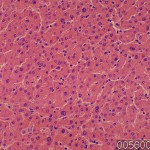| Product name | Liver, normal |
| Cat. No. | 0056000C |
| No. of samples | 1 |
| Description | liver, normal Age/Sex : 75/F |
| Price | 197 EUR |
| 260 USD | |
| 170 GBP |
Product Related Literature
The liver, an important organ in animals and some other vertebrates are present. It has a wide range of functions, including detoxification, protein synthesis, and production of bio-chemical and necessary for digestion. It can be used in the short term new technologies liver dialysis, a method of compensating required for survival, the lack of long-term liver function, there is currently no liver. It plays an important role in metabolism, glycogen storage, disintegration of red blood cells, plasma protein synthesis, hormone production, and the body has a number of functions in the body, including detoxification. It is located below the diaphragm in the abdominal-pelvic region of the abdomen. It produces alkaline compound to help digestion by emulsifying bile, the lipid. Many of them, small is necessary for the normal function of life, organization highly specialized liver is to regulate a wide range of mass biochemical reactions such as decomposition and synthesis of complex molecules.
The liver is a reddish brown organ with four leaf shape and unequal size. Human liver, has soft weight and 1.44 to 1.66 kg of normal (3.2 to 3.7 kg), brown tinged with pink, the organ of the triangle. (Skin is the largest organ overall) and the internal organs of the maximum, this is the largest gland in the human body. It just resting on the diaphragm below, I am located in the upper right quadrant of the abdominal cavity. Liver is located to overlap gallbladder and right stomach. Is connected to the large vessels of the two, it is called what’s called portal vein and hepatic artery one. Not only the entire intestinal tract, whereas carry blood containing the nutrients absorbed from the pancreas and spleen, hepatic artery carries blood from the aorta to the portal vein. These vessels subdivided into capillaries lead to small leaves then. Each lobule is made up liver cells, which is the main metabolic cages, with several million people. Unit is the functional unit of the liver.
Long-term bile duct was prepared from the woody branches biliary. Is collected in the merge bile canaliculi to form a bile duct bile produced by the liver. In the liver, ducts are called (in the liver) bile duct liver, they are considered to be (outside the liver) liver once, and then exit the liver. The merged to form the hepatic duct common Finally, intrahepatic duct discharging to the left and right hepatic duct. Cystic duct from the gallbladder joins the liver of common duct to form the common bile duct. The duodenum and through stored in gallbladder temporarily through the cystic duct or bile duct or bile duct directly. Pancreatic duct and common bile duct enter the second part of the duodenum in the ampoule along the Vater.
When viewed from the gross anatomical top surface of the additional splitting the liver (left and right) of two parts, but if there, is divided into four parts visceral surface plus the tail lobes square. A link that curved looks (front side) front of the liver. This separates the anatomical right leaf anatomy and the left liver lobe. If you turned to look at it from the liver (visceral surface) below, there is a partition of two additional between the left and right. Tail lobe and (high) square leaf These are (bottom).
Determine visceral surface functional anatomy, how to organize the liver. Imaginary line that runs the gallbladder split in half and all the way to the inferior vena cava from the left you should see one. This line is called the line-scan her. This line divides the liver to the left and right. (Ligament of Aranshio) venous ligament such as round ligament (ligament teres), anatomical and other characteristics, are still separated on the left side of the liver sections of two more. Now, an important anatomical landmark, horizontal slit of the liver, separates this part of the left segment of the four numbers starting from the tail lobule as well as the anti-clock mode is attached, of the liver. Eight segment will only be seen top view, from this point of view, we can see the 7 segment of the internal organs. It is composed of units of each of the lobes, is then run from binding around the hepatic veins to carry the blood from the liver vein.

